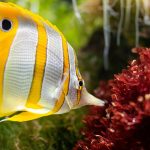How To Take Care Of A Dwarf Seahorse
In this post, we are going to discuss how to care for a dwarf seahorse. One of the most iconic creatures of the sea, seahorses can become one of the most interesting fish in any rather ordinary marine tank. But select them carefully! Make sure that they’re tank raised for two reasons: (1) they need to be able to eat by themselves, and (2) they must not be captured or removed from the ocean since they’re endangered.
Found in shallow tropical and temperate waters throughout the world, these upright-swimming relatives of the pipefish can range in size from 0.6 inches to 2 inches for dwarf seahorses and up to 14 inches long for Kuda seahorses.
Dwarf seahorses are truly unique, and not just because of their unusual equine shape.
Dwarf Seahorse Care
Dwarf seahorse care can be more complicated than caring for their larger cousins because of their smaller size. When setting up a dwarf seahorse tank, keep it simple! Dwarf seahorses prefer a smaller tank, anywhere from two – ten gallons will be plenty to keep 20 to 40 seahorses.
If you are just beginning your dwarf seahorse tank, you should have at least three males and three females to start. Unlike most other fish, they are monogamous and mate for life. Rarer still, they are among the only animal species on earth in which the male bears the unborn young. So calling the male “pregnant” is strangely accurate.
Male dwarf seahorses are equipped with a brood pouch on their ventral, or front-facing, side. When mating, the female deposits her eggs into his pouch, and the male fertilizes them internally. He carries the eggs in his pouch until they hatch, then releases fully formed, miniature seahorses into the water.
The exact gestation period of the seahorses is not known but is believed to be around 21 days. They will breed quickly and produce offspring up to three times a year.
Dwarf Seahorse Tank Setup
Because of their body shape and lack of extensive fins, seahorses are rather inept swimmers and can easily die of exhaustion when caught in high current tanks. They propel themselves by using a small fin on their back that flutters up to 35 times per second. Even smaller pectoral fins located near the back of the head are used for steering.
Because of this, you want to use an air filter to keep water flow to a minimum. A low current tank also allows them to feed properly, more on feeding in a little bit.
Keep water temperature between 70 – 74 degrees and perform regular water changes and tank cleanings twice a week. Using a sponge filtration system will also help in keeping the tank clean and also remove some harmful bacteria.
Always perform regular water testing to make sure ammonia and nitrites are kept to a minimum. Salinity should be kept right at around 1.023.
Finally, most experts recommend keeping a clean bottom tank meaning that you should not have any substrate, coral or live plants. The reasoning for this is that sand or rock can have microscopic creatures living within it that can be harmful to dwarf seahorses.
If you do want to dress up your tank, be sure to use fake rocks or plants to avoid contaminates.
What Do Dwarf Seahorses Eat
Dwarf seahorses do not like to hunt, they anchor themselves with their prehensile tails to seagrasses and other items in their tank, and using their elongated snouts to suck in any food that might drift by.
Voracious eaters, they will only eat live food and graze continually. They can consume 3,000 or more live copepods or brine shrimp per day.
Maintain a regular feeding schedule of two to four feedings per day, if after four hours you can still see live food swimming around, then you need to reduce the amount you are giving them.
Kuda Seahorse Care
Not to be mistaken for their smaller cousins, Kuda seahorses can become up to 12 inches in length. Kuda seahorses come in many colors – yellow, gray, brown, striped. They also have the ability to match the background of their environment, helping them escape detection by predators. The maximum length of Tiger Tails is about 6 inches.
Because of their need for slow-moving currents and lower temperatures (about 70-73 degrees), Kuda seahorses can be kept in a 30-gallon tank with live rock and a simple, hang-on filter with flow control. We can also recommend some fish that will enjoy the cooler water.
In captivity, seahorses such as Kudas eat PE Mysis shrimp.
Conclusion
We hope this post about dwarf seahorse care has been helpful. As you can see they can be considered difficult to care for the frequent water changes and feeding requirements. However, a thriving dwarf seahorse tank can extremely be gratifying and rewarding. Please let us know in the comments below any other issues you may have run into or post pictures of your thriving tanks. We would love to share it with our community!








